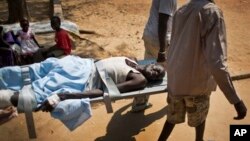It’s now estimated that 40 percent of South Sudan’s population – or 4.6 million people – now face acute hunger in the next three months. The World Food Program warned food insecurity is growing worse both in conflict and non-conflict areas.
The WFP said hunger is reaching record levels in South Sudan. Spokesman George Fominyen explained a combination of problems is to blame.
“South Sudan is facing the worst levels of food insecurity the young country has faced since independence because of conflict, high food prices and a worsening economic crisis,” he said.
The warning follows the release of the latest Integrated Food Security Phase Classification analysis. The IPC is a scale that weighs food security, nutrition and livelihood data to determine the severity of a food crisis. It was first developed for Somalia.
It said that “unrelenting conflict and the onset of the lean season” – when food needs are the highest – “are intensifying alarming levels of hunger” in much of the country.
“The latest analysis shows that the bulk of these people, who are facing these high levels of food insecurity, are in the conflict-affected states of the greater Upper Nile. We’re talking about Unity, Upper Nile State and Jonglei State,” said Fominyen.
Conflict is also making food insecurity worse in Northern Bahr el Ghazal and Warrap States.
Aid agencies are using air drops, boats, food distributions and cash vouchers to try to deal with the situation.
He said, “The World Food Program and its partners have been working flat out for months now trying to ensure that we can provide food assistance to those who are in need and we are continuing in this way. In the conflict-affected areas we’ve been ensuring a regular supply of life saving food assistance through our rapid response missions, in particular.”
Fominyen said, despite the efforts, humanitarian workers are having a harder time reaching those in need.
“The renewed hostilities and the increased insecurity and intensifying harassment of humanitarian workers means that we’re facing, what we call, shrinking humanitarian space available for us to work,” he said.
The World Food Program said it’s facing a $230 million shortfall over the next six months. But even if the money is received, can aid agencies overcome the obstacles they face?
“That’s a very good question because South Sudan is a very challenging area for humanitarian operations. Because of infrastructure difficulties, which we face, the logistics operation here is quite heavy," Fominyen said. "If we don’t have money in good time, we will not be able to procure in time. And once you’re not able to procure in time it becomes even much more complicated to move the food into the country.”
He said the rainy season has begun and in the coming months many parts of the country will become inaccessible by road. Transporting supplies by truck is the cheapest method. Air drops are most expensive.
Fominyen added that a return to peace is essential not only for humanitarian operations, but for people to return to their livelihoods.









